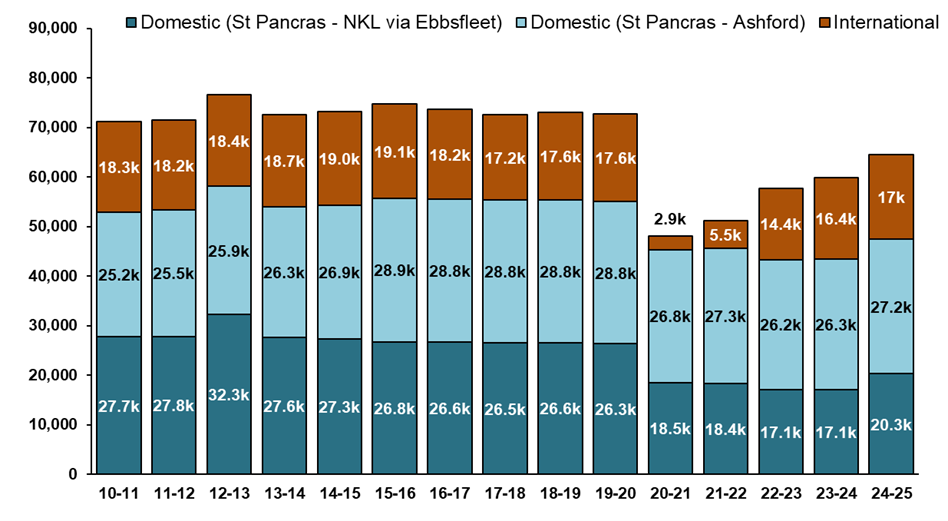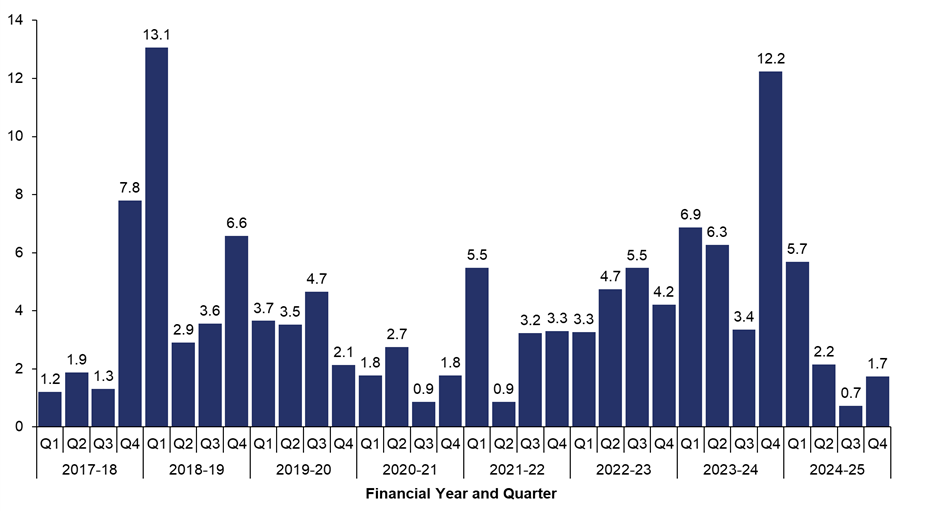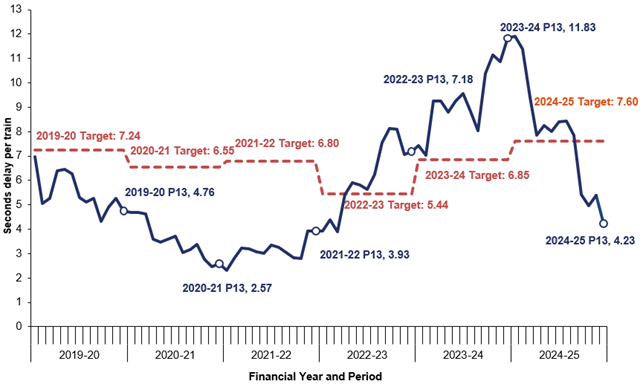Traffic volume
The total number of trains timetabled from 1 April 2024 to 31 March 2025 was 64,776. This is an 8% increase compared to the 60,134 in the previous year, but an 11% decrease compared to the 73,076 in the period 1 April 2019 to 31 March 2020 (the year before the COVID-19 pandemic).
International services increased by 3% in the latest year (to 17,017) compared to the previous year (16,442), remaining 3% below the number of services operated before the pandemic. However, the domestic Southeastern North Kent Line (NKL) services in the latest year (20,265) were 23% below the number operated during 1 April 2019 – 31 March 2020 (26,200).
Please note that some of the figures for train delays in this chapter may be subject to revision, due to the normal, ongoing process of delay attribution.
Figure 2.1 Number of passenger train services timetabled on HS1, 1 April 2010 to 31 March 2025

Source: London St. Pancras Highspeed Performance Floor Report
The number of freight train services expected to run on HS1 increased by 29% compared to the previous year (up from 233 last year to 300). However, as anticipated from discussions during PR24, freight ceased running in July 2024, so only 59 trains actually ran in the year.
Train service performance
We monitor two measures of train service performance. Firstly, London St. Pancras Highspeed submits to us quarterly and annual performance floor reports demonstrating its operational performance against minimum thresholds set out in its Concession Agreement. These state that the proportion of services delayed by London St. Pancras Highspeed in a quarter should not exceed 15%, and in a year must not exceed 13%.
However, both London St. Pancras Highspeed and its users expect much higher levels of performance than this. As a result, London St. Pancras Highspeed set itself – and its subcontractor NR(HS) – a separate, more stretching, target, which we also monitor.
Performance against minimum threshold
Table 2.1 shows a breakdown of performance for the year ending 31 March 2025.
Table 2.1 HS1 train service performance: 1 April 2024 – 31 March 2025
| Service type | Total number of trains timetabled | Total number of delayed trains (attributed to HS1) | Delayed trains (attributed to HS1) as a percentage of timetabled trains | Total number of delayed trains (unknown cause) |
|---|---|---|---|---|
| Domestic (London St. Pancras – North Kent Line via Ebbsfleet International) | 20,265 | 25 | 0.12% | 21 |
| Domestic (London St. Pancras – Ashford International) | 27,194 | 94 | 0.35% | 21 |
| International | 17,017 | 50 | 0.29% | 1 |
| Freight | 300 | 0 | 0.00% | 0 |
| Total | 64,776 | 169 | 0.26% | 43 |
Source: London St. Pancras Highspeed Performance Floor Report
The proportion of trains delayed by London St. Pancras Highspeed-attributable incidents in the latest year was well within the allowable standards set out in the Concession Agreement (13%), at 0.26%. The 169 delayed services attributable to London St. Pancras Highspeed (for example, due to trespass on the network, or points failures) in the latest year was a 63% decrease on the 458 services delayed in the previous year. Additionally, the number of delayed trains for the latest year represents a 37% decrease on the 249 services delayed five years ago before the pandemic. The quarterly breakdown of these delays is shown in Figure 2.2.
Figure 2.2 Delayed train services per 1,000 trains operated attributed to London St. Pancras Highspeed by quarter, 1 April 2017 to 31 March 2025

Source: London St. Pancras Highspeed Performance Floor Report
Performance against stretch target
In terms of the stretch target it sets itself for the latest year (7.60 seconds delay per train), the average delay per train due to London St. Pancras Highspeed-attributable incidents was better than the target, at 4.23 seconds. A considerable improvement has been seen since the previous year, when the average delay per train was 11.83 seconds. Figure 2.3 shows the year-on-year average delay per train service attributed to London St. Pancras Highspeed in this control period.
Figure 2.3 Moving annual average delay per train service attributed to London St. Pancras Highspeed by period, 1 April 2019 – 31 March 2025

Source: London St. Pancras Highspeed Asset Management Annual Statement (AMAS), 1 April 2024 to 31 March 2025.
In summary, there has been a trend of decreasing delays over this year, falling within target roughly halfway through the year. We have seen London St. Pancras Highspeed focus on returning to achieving the level of train service provision it set itself as a stretch target, and we will continue to challenge London St. Pancras Highspeed and NR(HS) to ensure that it is minimising delays through best practice asset management, as discussed in the following chapter.

